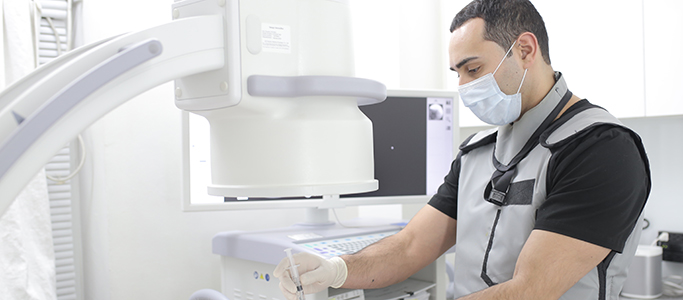What Doctor To See For Back Pain
12/08/2020
Lower back pain is the most prevalent type of spinal pain. It has several different causes, including dysfunction in the sacroiliac joint (SJ). When there is a problem with your SI joint, you can feel lumbar spine pain and/or leg pain. Unlike in the past, New York pain doctors can diagnose sacroiliac joint pain with ease and provide the right forms of treatment. It is easily mistaken for sciatica, the radiating leg pain that affects the sciatic nerve when it gets pinched by a herniated lumbar disc.
Pain due to sciatica or SI joint feels almost the same. That’s why you need to know what doctor to see for back pain. He or she should be an expert back surgeon who understands the difference between sciatica leg pain and SI joint leg pain. Since sacroiliac joint causes fifteen to thirty percent of all lower back pain cases, your pain doctor will check on your joint during diagnosis.

The SI joint anatomy
To understand why and how your sacroiliac joint can be the cause of your lumbar spine pain, you should know its anatomy. The SI joint connects the iliac crests (hip bones) to the sacrum. The sacrum is the triangular shaped bone that is located between the lumbar spine and coccyx (tail bone). Our SI joint is designed for shock absorption between our torso and the lower body (pelvis and legs). As it does not make big movements, the SI carries out the role of shock absorption so perfectly.
It also allows us to bend forward or backward with ease. Because it is supported by powerful ligaments that enclose it, the sacroiliac joint is able to restrict movements and absorb pressure. Besides the network of strong soft tissues that extend across the joint behind the pelvis area, the SI joint function is increased by gluteus maximus and the piriformis muscle. When there is a dysfunction of the SI, the best thing is to have your symptoms checked by one of the best New York pain doctors near you.

What causes problems in the sacroiliac joint?
Dysfunction in the SI joint can result from a number of primary factors. According to a highly qualified pain doctor like Dr. Michael Nguyen, these factors include the following:
- Excessive movement –In other words, this can be referred to us instability or hypermobility in the sacroiliac joint. It can make the pelvis unsteady, resulting to pain in the lower back or hip. Pain due to excessive movement in your SI can move into the groin area as well.
- Extremely small movement –This is called fixation or hypomobility in clinical terms. If there is too little movement in your sacroiliac joint, symptoms such as muscle tension, pain and stiffness can be felt. If there is pain, it will normally be felt on one side of your lower back or buttock. It may shift down the back of the affected leg and that’s what makes SI joint pain so similar to sciatic nerve pain.
Meeting the best New York pain doctors is important because you can find out the real cause of your lower back pain. And if it is sacroiliac joint dysfunction, the pain doctor will confirm what is causing it. Is it too much or too little movement in the SI joint? Could it be that you have sacroiliitis? This refers to the inflammation of the sacroiliac joint and it can cause a lot of stiffness and pain in your pelvic area. Inflammation of the joint may happen with the usual function of the joint or due to an infection like rheumatoid arthritis.
That’s why you want to see one the top New York pain doctors as soon as you notice that your pain is worsening. One thing you should also note is that your risk is higher if you are a young or middle-aged female. As well, pregnant ladies or those who have given birth recently are highly prone to SI joint pain.
Symptoms to take to a pain doctor
If you have lower back pain due to a sacroiliac joint dysfunction, expect the following symptoms.
- Lumbar spine pain –This is the most common sign people who have SI joint dysfunction notice. It tends to be a dull ache that can range from mild to serious pain and will typically affect just one side of the lower back area. In some rare cases though, SI joint dull pain can affect both sides of your lower back.
- Pain that feels like sciatica –This pain is felt in the buttocks and/or back of the thighs. It tends to be hot, sharp or stabbing sort of pain. Sometimes it is accompanied by tingling and numbness and will never go beyond your knee joint. That’s the main difference between sciatica and sacroiliac joint pain. The former can affect your lower leg and feet while the latter hardly goes beyond your knee. It is important to know what doctor to see for back pain caused by a dysfunctional SI joint as you want this type of discomfort discovered accurately.
- Pain that affects your bottom –This includes your hips, buttocks and groin area. While it may not affect all the three areas, pain due to a problematic SI joint will almost always occur in the buttocks or side of the thigh. It tends to affect one side at a time and sometimes both sides at once. If you notice this kind of radiating pain, call your pain doctor
- Pain that worsens only with certain activities –When sacroiliac joint is not functioning well, the ache can worsen when climbing a staircase, jogging or running. It can also get worse when you try lying on one side as this shifts more weight to that side. Most New York pain doctors will ask about these symptoms just to verify that your SI joint is dysfunctional.
- Instability -This usually affects your pelvis and/or the lumbar spine area. If your pelvis feels like it could give way when you stand up, walk or change from standing up to sitting down, it is likely to be unstable because of sacroiliac joint dysfunction.
- Stiffness-If your lower back, pelvis, hips and groin are feeling stiff, you need to meet the right New York pain doctors for a check up. Sacroiliitis is joint inflammation that could cause stiffness or reduced range of motion.
If you were born with gait problems (scoliosis), they can place excessive pressure on one side of your pelvis. This can cause friction on your SI joint and increase your pain. So, have your joint examined by the most reliable pain doctor in your area. Moreover, people who have had lumbar spine surgery, such as a fusion surgery, in the past can experience sacroiliac joint pain. Some people can also feel lower back pain due to a dysfunctional sacroiliac joint after undergoing a hip joint replacement surgery where bone grafts were harvested from the iliac bone.
Hence, it is wise to inform the preferred New York pain doctors about all the surgeries you did before. If there are activities that you do and they place continuous stress on your SI joint, such as weight lifting, strenuous jobs, contact sports or prolonged standing or sitting, your lower back pain could be sprouting from the Sacroiliac joint. In case you have had a recent fall, it could be that the injury or trauma affected your SI joint. Get in touch with a pain doctor and have the joint examined as soon as possible.
Diagnosing SI joint issues
The selected pain doctor will perform several different tests to determine if the symptoms one is experiencing are due to a dysfunctional SI joint. Their tests will include the following:
- Physical examination. The top New York pain doctors must carry out this test. It entails movements meant to awaken pain in the SI joint. If the three or more maneuvers cause pain, the doctor will conclude that the sacroiliac joint might be the cause of lower back pain.
- Common diagnostic tests like X-ray, MRI and/CT scan. This can be carried out to confirm that there are no other sources of back pain.
- Diagnostic injection of the SI joint –This is when the pain doctor injects the affected joint with a local anesthetic drug to see if your pain will significantly reduce. If it does, then the SI joint is the main source of pain in the lower back.
Sometimes the New York pain doctors will decide to do several different orthopedic provocation tests. This is to help them disqualify or identify the sacroiliac joint as the main cause of lumbar spine pain. These types of tests include the following:
- Faber test
- Sacral thrust test
- Distraction test
- Palpitation test
If a combination of all the above-mentioned tests produce related pain response over the affected SI joint and other causes have been disqualified, your pain doctor will conclude that you have a dysfunctional sacroiliac joint. Then the treatment plan will be designed and started.
Dysfunctional SI joint treatment options
The most basic sacroiliac joint treatments include taking a short rest and applying cold or heat. A patient may be advised to stop working for one or two days. A period of rest that is longer than two days can actually aggravate your SI joint stiffness and pain. So, stop resting when your pain doctor asked you to. As for the application of heat or ice, it can reduce pain and discomfort. Ice to be specific is used to reduce inflammation and pain and it should be placed on the aching area of your lower back or pelvis. Heat can be applied later on to relax tense muscles and reduce the discomfort caused by muscle spasms.
Besides the afore-said option, the New York pain doctors do prescribed specific drugs for reducing pain. These can also bought from a local pharmacist’s shop and include NSAIDs like naproxen and ibuprofen. Acetaminophen is also an OTC pain killer that can work. If these don’t offer enough relief, your physician can prescribe narcotic drugs and/or muscle relaxants. These can be so useful when you have strong episodes of severe lower back pain. Your pain doctor will be careful though, as these two types of drugs can be addictive and can trigger a lot of bad side effects. Other than these, the New York pain doctors can offer other treatment options:
- Brace -If it is found out that your sacroiliac joint is extremely loose or hypermobile, your back specialist may recommend a brace to support your pelvis. The brace is often wrapped around the waist and pulled tightly to keep the pelvis stable. When you have joint pain and inflammation, the wide pelvic brace will be recommended.
- Joint injections –This entails sacroiliac joint shots with a local anesthetic drug like bupivacaine or lidocaine and an anti-inflammatory drug like a corticosteroid. This does not only reduce pain but also the inflammation. This injection can cause pain relief that would allow a patient to start his or her physical therapy program and go back to their usual daily activities.
- Chiropractic help –Your New York pain doctors might also decide to apply chiropractic techniques of pain alleviation. These entail manual manipulation of the back and can be extremely useful if the cause of SI joint pain is too little movement. Other than chiropractors, manual manipulation of the spine can be done by an osteopathic doctor and your pain doctor can recommend one to you.
Although there are different ways to treat SI joint pain, there is no one approach that will work for each patient and it is upon your doctor to decide what’s best for you. There are times when surgery is the only choice left to use and this is when all non-surgical cures have failed to work. The most common type of surgery is called sacroiliac fusion and it entails the use implanted rods and screws and a bone graft to restore the joint function. It is good to know what doctor to see for back pain if you must do fusion surgery to increase your success rate and reduce complications. As with other types of surgeries, fusion surgery can cause complications that the preferred New York pain doctors should talk about before operating on you.
Book a Consultation
Scheduling a consultation with one of our pain treatment specialists is one of the best ways to determine the proper solution for pain relief.














